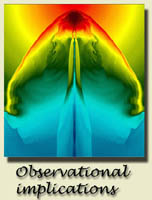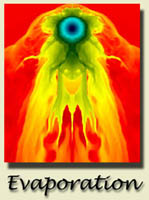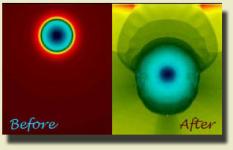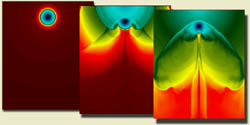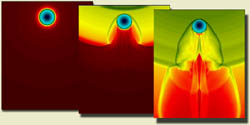
One method of discriminating between the many Type Ia progenitor scenarios is by searching for contaminating hydrogen and helium stripped from the companion star. However, this requires understanding the effect of the impact of the supernova shell on different companion stars to predict the amount of mass stripped and its distribution in velocity and solid angle for the types of binary scenarios that have been proposed as Type Ia progenitor models.
We present several high-resolution 2-D numerical simulations of the impact of a Type Ia supernova explosion with hydrogen-rich main sequence, subgiant, and red giant companions. The binary parameters were chosen to represent several classes of single-degenerate Type Ia progenitor models that have been suggested in the literature. We use realistic stellar models and supernova debris profiles to represent each binary system. For each scenario, we explore the hydrodynamics of the supernova-secondary interaction, calculate the amount of stellar material stripped from the secondary and the kick delivered by the impact, and construct the velocity and solid angle distributions of the stripped material.
We find that the main sequence and subgiant companions lose 0.15-0.17 solar masses as a result of the impact of the supernova shell, $15\%$ of their mass. The red giant companions lose 0.53-0.54 solar masses, 96%-98% of their envelopes. The characteristic velocity of the stripped hydrogen is less than 103 km s-1 for all the scenarios: 420 - 590 km s-1 for the red giant companions, 820 km s-1 for the main sequence companion, and 890 km s-1 for the subgiant companion. The stripped hydrogen and helium contaminate a wide solid angle behind the companion: 115o from the downstream axis for the red giant, 66o for the main sequence star, and 72o for the subgiant. With such low velocities, the bulk of the stripped hydrogen and helium is embedded within the low-velocity iron of the supernova ejecta. The hydrogen and helium may be visible in the late-time spectra as narrow emission lines.
Although most of the stripped material is ejected at low velocities, all the numerical simulations yield a small high-velocity tail. The main sequence, subgiant, and the red giant companions are just under the Della Valle et al. (1996) upper limit from observations of SN 1990M taken near maximum light.
The main sequence companion receives a kick of 86 km s-1 and the subgiant receives a kick of $49$ \kmsecc. In all cases, the kick to the remnant is smaller than the original orbital velocity. Because it is too small to intercept more than a negligible amount of momentum, the red giant core will not receive an appreciable kick.
The impact of the supernova ejecta with the secondary star creates a hole in the supernova debris with an angular size of ~30o in the high-velocity ejecta and with an angular size of ~40o in the low-velocity ejecta. This corresponds to 7-12% of the ejecta's surface. Because we explore binary scenarios that are close enough, or almost close enough, to be in Roche lobe overflow, the degree of asymmetry is similar for all the models. The asymmetry in the supernova debris could have observational consequences beyond the change in morphology of the supernova remnant. The asymmetry in the supernova atmosphere will result in distorted P Cygni profiles that might indicate the presence of the companion star, but it will be difficult to use the degree of asymmetry alone to discriminate between a main sequence, subgiant, or red giant companion.
The impact of the supernova shell will have consequences for the future evolution of the secondary star. After the impact, the main sequence star is puffed up, much like a pre-main sequence star. The luminosity will rise dramatically, to as high as ~5000 solar luminosities, as the extended envelope relaxes back into thermal equilibrium. The subgiant companion will follow a similar sequence of events. The star will not be contaminated by much supernova debris from the initial impact, but it may accrete low-velocity iron-group elements (or oxygen and silicon if the ejecta is radially mixed) at late times.
A He pre-white dwarf will be left behind after a supernova explosion with a red giant companion. Almost all the envelope will be ejected by the impact, but a residual amount of material (~0.02 solar masses) will form an extended, hydrogen-rich envelope around the degenerate core. The star will evolve away from the red giant branch on a timescale of 105-106 years. On its post-RG track, it may appear as an underluminous O or B star before passing through an sdO or sdB phase on its way to a standard He white dwarf cooling track. This binary scenario could be a possible pathway for the formation of a subset of single, low-mass He white dwarfs.
